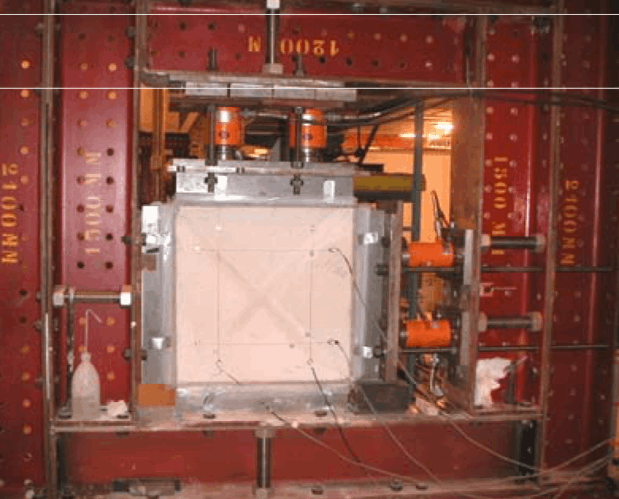A.T. Vermeltfoort1 and B.M. Ng’andu2
- Assistant Professor, Dept of Architecture, Building and Planning, Eindhoven University of Technology, Vertigo Building, PObox 513, 5600 MB Eindhoven, The Netherlands, a.t.vermeltfoort@tue.nl
- PhD Student, Dept of Architecture, Building and Planning, Eindhoven University of Technology.
ABSTRACT
This paper describes and presents results of an experimental programme investigating the structural response of 630 mm long by 630 mm wide by 100 mm thick, wallettes made of calcium silicate elements laid in thin layer mortar. This material is increasingly employed in wall construction in Europe.
Wallettes were built, using thin layer mortar, from one large and two small triangular pieces cut from 600 mm by 900 mm by 100 mm elements. The wallettes had one long diagonal joint (900 mm) and one short diagonal joint (450 mm). The four, 630 mm by 100 mm side surfaces were loaded.
Calcium silicate prisms cut from elements were tested separately in uni-axial compression. Each of thirteen wallettes was subjected to an in-plane combined vertical and horizontal load, the ratio of which was varied. Deformations measured in both directions allowed for the establishment of the modulus of elasticity and Poisson’s ratio.
A small horizontal/vertical loading ratio caused shear over the long diagonal joint. With higher ratios the wallettes behaved isotropically. Load-deformation curves show linear behaviour to almost peak load. However, in some cases deviations were found. In some cases the edges failed while in other cases fracture occurred in the bed joint. The responses, together with the stress strain relationships and failure behaviour provide a data base that can be used to calibrate a finite element model of larger walls.
KEYWORDS: bi-axial compression, Poisson’s ratio, CASIELs, thin layer mortar, stiffness
2b-1



